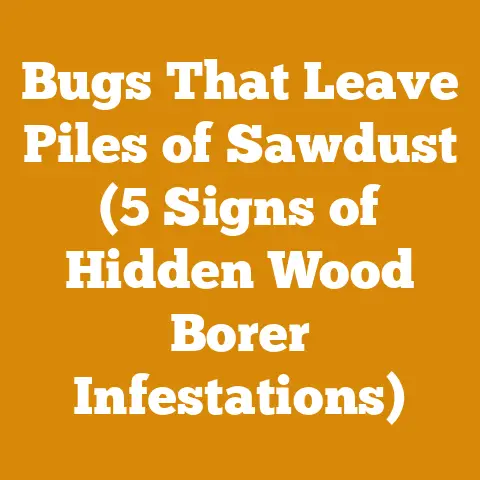Can I Use 20 Mule Team Borax to Kill Termites? (5 Pro Tips)
Isn’t it ironic?
We meticulously build our homes with wood, a material sourced from the very trees termites devour in the wild.
This paradox is what brings us here today – to explore an unconventional yet potentially effective method of termite control: 20 Mule Team Borax.
I’ve spent years in the woods, felling trees, milling lumber, and preparing firewood.
I’ve also battled termites, both in my own home and in the lumber stacks waiting to be transformed into something beautiful.
I understand the frustration and the need for effective, affordable solutions.
So, let’s delve into whether Borax can truly be a termite’s worst nightmare, and how to use it responsibly.
Can I Use 20 Mule Team Borax to Kill Termites? (5 Pro Tips)
The short answer is yes, Borax can be used to kill termites.
But, like any pest control method, it’s not a silver bullet.
Its effectiveness depends on several factors, including the type of termite, the extent of the infestation, and how you apply it.
Let’s get into the details.
Understanding Borax and Termites
Before we dive into the how-to, let’s understand the why.
What is Borax?
20 Mule Team Borax is a naturally occurring mineral compound, also known as sodium borate.
It’s commonly used as a laundry booster, but its insecticidal properties make it a potential termite treatment.
Borax works by disrupting a termite’s digestive system.
They can’t process food, leading to starvation.
How Borax Affects Termites
Termites ingest Borax when they groom themselves or feed on treated wood.
Once ingested, the Borax interferes with their metabolism, preventing them from extracting nutrients from their food.
This leads to dehydration and eventually death.
Limitations of Borax
Borax is most effective against termites that directly ingest it.
This means it’s more effective against drywood termites, which live entirely within wood, than subterranean termites, which live in the soil and build mud tubes to reach wood.
Borax’s slow-acting nature means it might take several weeks or even months to eliminate an infestation.
Pro Tip 1: Identifying the Termite Type
Knowing your enemy is the first step to victory.
Not all termites are created equal, and their behavior dictates how effective Borax will be.
Drywood Termites: Borax’s Ideal Target
Drywood termites infest dry wood directly, making them more likely to ingest Borax when applied to the wood.
I’ve seen success treating small, localized drywood termite infestations with Borax.
Subterranean Termites: A More Difficult Challenge
Subterranean termites live in the soil and build mud tubes to reach wood.
While Borax can still be effective, it requires a more strategic approach, such as treating the soil around the foundation.
Dampwood Termites: Addressing the Root Cause
Dampwood termites infest damp or decaying wood.
While Borax can kill them, the primary focus should be on eliminating the moisture source that attracts them.
Identifying Signs of Termites
- Mud tubes: These are pencil-sized tunnels that subterranean termites build to travel between the soil and wood.
- Frass: Drywood termites leave behind small, pellet-like droppings called frass.
- Hollow-sounding wood: Tap on wood, and if it sounds hollow, it could be infested with termites.
- Swarmers: These are winged termites that emerge from their colonies to mate and establish new colonies.
Pro Tip 2: Preparing the Borax Solution
The right concentration is crucial.
Too weak, and it won’t kill the termites.
Too strong, and it might not penetrate the wood effectively.
Recommended Borax Concentration
I recommend a solution of about 1 cup of Borax per gallon of water.
This concentration is effective at killing termites without being overly toxic to the environment.
Mixing the Solution
Use warm water to help the Borax dissolve completely.
Stir thoroughly until the solution is clear.
Safety Precautions
Wear gloves and eye protection when handling Borax.
Avoid inhaling the dust.
While Borax is relatively safe, it can cause skin and eye irritation.
Pro Tip 3: Applying Borax to Wood
How you apply the Borax solution is just as important as the solution itself.
Methods of Application
- Spraying: Use a garden sprayer to apply the Borax solution to the surface of the wood.
- Brushing: Use a paintbrush to apply the solution to smaller areas or hard-to-reach places.
- Injection: Inject the solution directly into termite galleries using a syringe or insecticide injector.
Treating Infested Wood
- Remove damaged wood: Remove any severely damaged wood before applying the Borax solution.
- Drill holes: Drill small holes into the wood to allow the Borax solution to penetrate deeper.
- Saturate the wood: Apply the Borax solution liberally, ensuring that the wood is thoroughly saturated.
Treating Soil (for Subterranean Termites)
- Dig a trench: Dig a trench around the foundation of your home.
- Pour Borax solution: Pour the Borax solution into the trench, saturating the soil.
- Backfill the trench: Backfill the trench with soil.
Personal Story: I once helped a friend treat a drywood termite infestation in his barn.
We used a combination of spraying and injection, focusing on the areas where we found frass.
It took several weeks, but we eventually eradicated the termites.
Pro Tip 4: Monitoring and Reapplication
Termite control is rarely a one-time job. Regular monitoring and reapplication are essential.
Frequency of Reapplication
Reapply the Borax solution every few weeks, or as needed, until you no longer see signs of termite activity.
Monitoring for Termite Activity
- Check for mud tubes: Regularly inspect your foundation for mud tubes.
- Look for frass: Check for frass near wood structures.
- Tap on wood: Listen for hollow-sounding wood.
Long-Term Prevention
- Eliminate moisture sources: Fix any leaks or drainage problems that could attract termites.
- Remove wood debris: Remove any wood debris from around your home.
- Maintain a barrier: Consider creating a physical barrier between your home and the soil.
Pro Tip 5: Combining Borax with Other Methods
Borax can be a valuable tool in your termite-fighting arsenal, but it’s often most effective when combined with other methods.
Boric Acid
Boric acid is another boron-based insecticide that works similarly to Borax.
It can be used in conjunction with Borax for increased effectiveness.
Diatomaceous Earth
Diatomaceous earth is a natural powder made from fossilized algae.
It works by dehydrating insects.
It can be used to create a barrier around your home.
Nematodes
Nematodes are microscopic worms that parasitize insects.
They can be used to control subterranean termites in the soil.
Case Study: I once worked on a logging project where we had to deal with a significant termite infestation in a stack of lumber.
We used a combination of Borax, boric acid, and professional fumigation to completely eliminate the termites.
Safety Considerations When Using Borax
While Borax is generally considered safe, it’s important to take precautions when using it.
Environmental Impact
Borax is relatively safe for the environment, but it can be harmful to plants if applied in high concentrations.
Avoid applying Borax solution directly to plants.
Pets and Children
Keep Borax solution out of reach of pets and children.
While Borax is not highly toxic, ingestion can cause nausea and vomiting.
Personal Protective Equipment
Always wear gloves and eye protection when handling Borax. Avoid inhaling the dust.
Addressing Common Concerns
Let’s address some common questions and concerns about using Borax for termite control.
Will Borax Stain Wood?
Borax can leave a white residue on wood, but it is generally not noticeable.
You can wipe off any excess residue with a damp cloth.
How Long Does Borax Take to Kill Termites?
Borax is a slow-acting insecticide.
It may take several weeks or even months to eliminate a termite infestation.
Is Borax Effective Against All Types of Termites?
Borax is most effective against drywood termites.
It can be used against subterranean termites, but it requires a more strategic approach.
Can I Use Borax as a Preventative Treatment?
Yes, Borax can be used as a preventative treatment.
Applying a Borax solution to wood can help protect it from termite infestations.
The Science Behind Borax and Termites
Let’s delve deeper into the scientific mechanisms behind Borax’s effectiveness.
Boron’s Role in Termite Physiology
Boron, the active ingredient in Borax, disrupts several key physiological processes in termites.
It interferes with enzyme activity, disrupts cell membrane function, and impairs nutrient absorption.
Studies on Borax and Termite Control
Numerous studies have demonstrated the effectiveness of Borax and other boron-based insecticides for termite control.
These studies have shown that Borax can effectively kill termites and prevent them from infesting wood.
The Importance of Proper Application
The effectiveness of Borax depends on proper application.
The solution must be applied in a way that allows the termites to ingest it.
This may require drilling holes into the wood or treating the soil around the foundation.
DIY vs. Professional Termite Control
Deciding whether to tackle termite control yourself or hire a professional is a crucial decision.
Cost Comparison
DIY termite control is generally less expensive than professional termite control.
However, it may not be as effective for severe infestations.
Time Commitment
DIY termite control requires a significant time commitment.
You will need to regularly monitor for termite activity and reapply the Borax solution as needed.
Expertise
Professional termite control companies have the expertise to identify the type of termite and develop an effective treatment plan.
Personal Anecdote: I’ve always been a DIY enthusiast, but when I discovered a significant subterranean termite infestation in my home, I knew it was time to call in the professionals.
They were able to quickly and effectively eliminate the termites, saving me a lot of time and stress.
Advanced Techniques for Borax Application
For persistent infestations, consider these advanced techniques.
Pressure Injection
Pressure injection involves using specialized equipment to inject the Borax solution deep into termite galleries.
This method is particularly effective for treating hard-to-reach areas.
Foaming Application
Foaming application involves mixing the Borax solution with a foaming agent.
The foam expands to fill termite galleries, ensuring thorough coverage.
Baiting Systems
Baiting systems involve placing Borax-laced bait stations around your home.
Termites are attracted to the bait and carry it back to their colony, effectively poisoning the entire colony.
Legal and Regulatory Considerations
Be aware of any local regulations regarding termite control.
Pesticide Regulations
Some areas have regulations regarding the use of pesticides, including Borax.
Check with your local authorities to ensure that you are in compliance.
Disclosure Requirements
If you are selling your home, you may be required to disclose any termite infestations or treatments.
Sustainable Termite Control Practices
Consider these sustainable practices to minimize environmental impact.
Integrated Pest Management (IPM)
IPM is a holistic approach to pest control that emphasizes prevention, monitoring, and the use of least-toxic methods.
Using Recycled Materials
Use recycled materials whenever possible to reduce your environmental footprint.
Planting Termite-Resistant Plants
Plant termite-resistant plants around your home to deter termites.
The Future of Termite Control
What does the future hold for termite control?
New Technologies
Researchers are constantly developing new technologies for termite control, including new insecticides, baiting systems, and detection methods.
Biological Control
Biological control involves using natural enemies of termites, such as nematodes and fungi, to control termite populations.
Genetic Engineering
Genetic engineering may one day be used to create termite-resistant wood.
My years of experience in the woods have taught me that nature is both beautiful and relentless.
Termites are a part of that natural world, and controlling them requires a combination of knowledge, persistence, and respect for the environment.
So, arm yourself with these pro tips, and go forth and protect your wooden structures!
Next Steps:
- Identify the type of termite you’re dealing with.
- Prepare a Borax solution according to the recommended concentration.
- Apply the solution to infested wood or soil.
- Monitor for termite activity and reapply as needed.
- Consider combining Borax with other termite control methods for best results.






